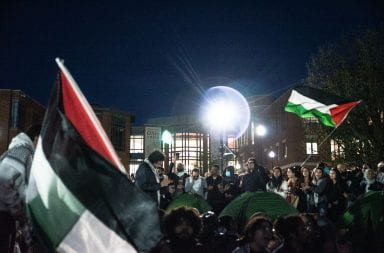
Students protest against President-elect Donald Trump on the Oval on Nov. 10. Credit: Dan Smyth | Lantern Reporter
Two days after a historic presidential election, Ohio State’s Oval was overtaken Thursday afternoon with a crowd of nearly 300 students against President-elect Donald Trump. Some wrapped themselves in rainbow flags, others carried signs denouncing Trump, and in the back of the crowd stood a handful of observers wearing bright-red “Make America Great Again” hats.
A separate protest was held downtown Thursday night, and OSU’s Black Student Association held a forum on open to all to discuss the election results. Undergraduate Student Government tweeted out a link to the website for OSU’s Counseling and Consultation Service on Wednesday, as well as a phone number.
Students lined up behind the William Oxley Thompson statue starting about noon, and took turns sharing their reactions to the election results, and speaking on how minority issues could be affected by a Trump administration.
“I was utterly shocked when I saw state after state go red,” said Quince Guttman, a fourth-year in chemistry and member of the LGBT community. “I saw my peers, who I thought were my friends, people who called themselves my ally, vote into office someone who would deny my humanity. This election they did not only vote Trump into office, but they voted all of us out of citizenship.”
Meera Mathur, a first-year in psychology, echoed Guttman’s feelings, saying she has heard stories of people being attacked over their skin color in the days following the election.
“I believe that that hateful ideology has been perpetuated by what Trump has been saying this entire campaign. The fact that he just got elected as the President of the United States condones all that,” Mathur said.
“I realized that all of our fear, all of our inability and all of our unwillingness to talk is what has resulted in this election.” — Ben Weaver, second-year in exploration
Supporters of Donald Trump in attendance felt differently.
“I don’t think people should have legitimate fears because power in our country changes a lot. Our system of democracy is setup to have checks and balances,” said Ben Lipp, a first-year in biomedical science.
Another Trump supporter in attendance, Jake Liddic, a second-year in business management, said protests build more division.
“I’m a big Trump guy, but I think this is kind of divisive,” he said. “I think if we want Trump supporters and Hillary and Bernie people to come together and have a dialogue on how we treat people, them saying ‘F Trump’ and stuff isn’t going to help me. I don’t think it’s unifying, I think it’s more divisive than anything.”
Liddic and Lipp were part of discussion circles that formed within the crowd between protesters and Trump supporters. The dialogue — some respectful, some antagonistic — was levied back-and-forth.
“I’m being judged for the color of my hat,” Liddic told a group of protesters.
Liddic, who said his goal for attending the protest was to open a dialogue between the parties, later explained his analogy to The Lantern.
“Obviously I’m not trying to equate the color of my hat with skin color or other things like that, but I am trying to draw on the fact that prejudices are formed on both sides,” he said.
Ashley Stewart, a third-year doctoral student in social work, was in the same discussion circle as Liddic. She said the platform for the discourse was powerful.
“It is essentially a discussion about perspective,” she said. “The gentlemen who I have been speaking to have been experiencing this election very differently than I have. We had a really great conversation about intent versus impact.”
Stewart elaborated on the heart of the disagreement.
“When we are saying we don’t accept Donald Trump as a president, we are saying we don’t accept the ideological views that come with marginalizing and oppressing people in our society,” she said. “Their perspective is totally different. They believe that he hasn’t said these things, that he hasn’t provoked these types of issues and are blaming it more on the media covering it the way they choose.”
Ben Weaver, a second-year in exploration, attempted to help both sides find common ground at the protests.
“I wasn’t really raised with a religion or anything, but I’m the kind of person who feels like I need to believe in something.” Weaver said. “I guess I kind of chose to believe in people for a while. I was kind of destroyed when I saw the results of the election because I thought the American people voted against standing together and voted for separation, but what I realized is that wasn’t the problem.”
Weaver explained his motivation for mediating between the two sides.
“I realized that all of our fear, all of our inability and all of our unwillingness to talk is what has resulted in this election,” he said.
More anti-Trump protests have been organized to take place Friday, both on campus and in the city.


